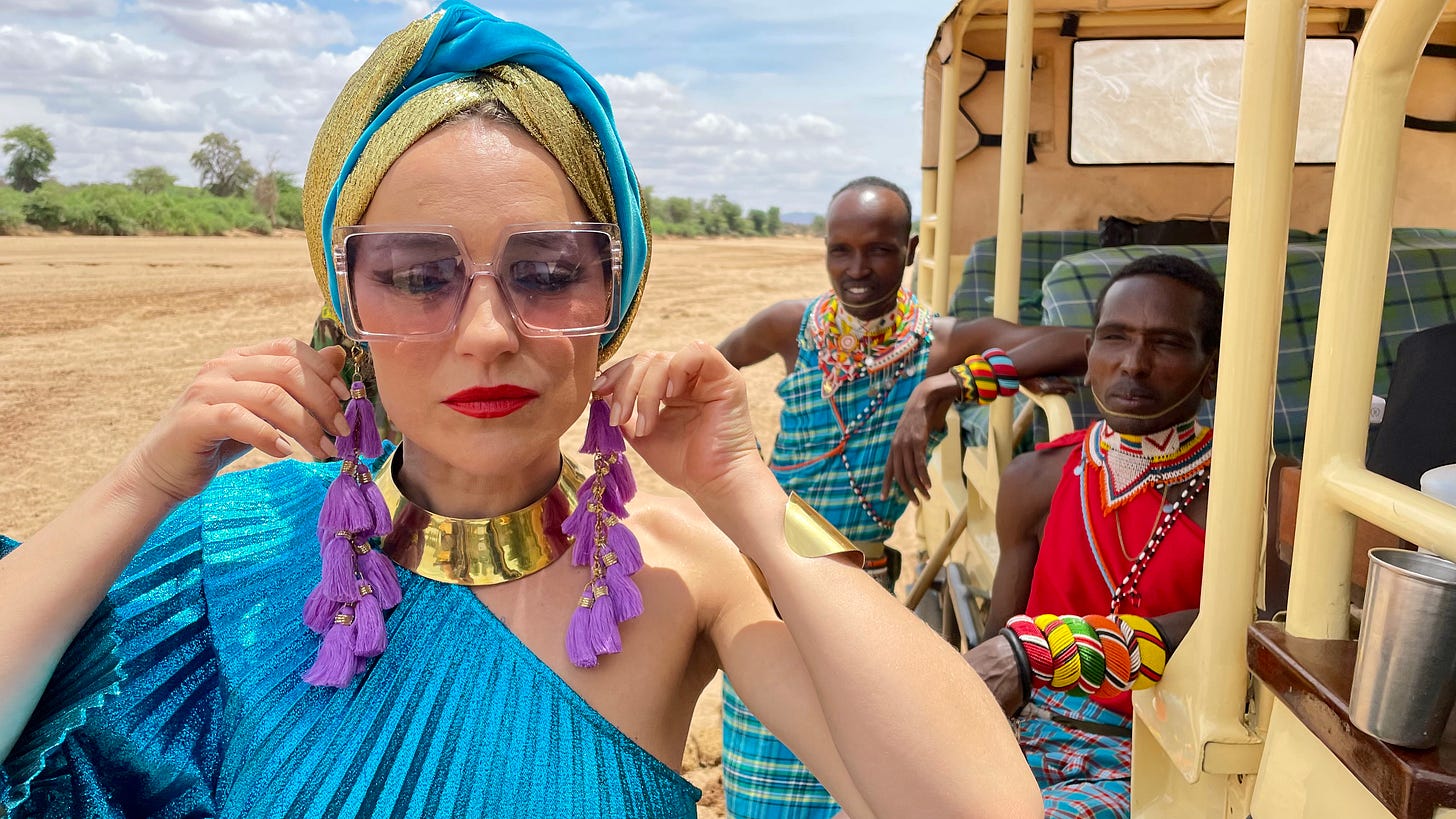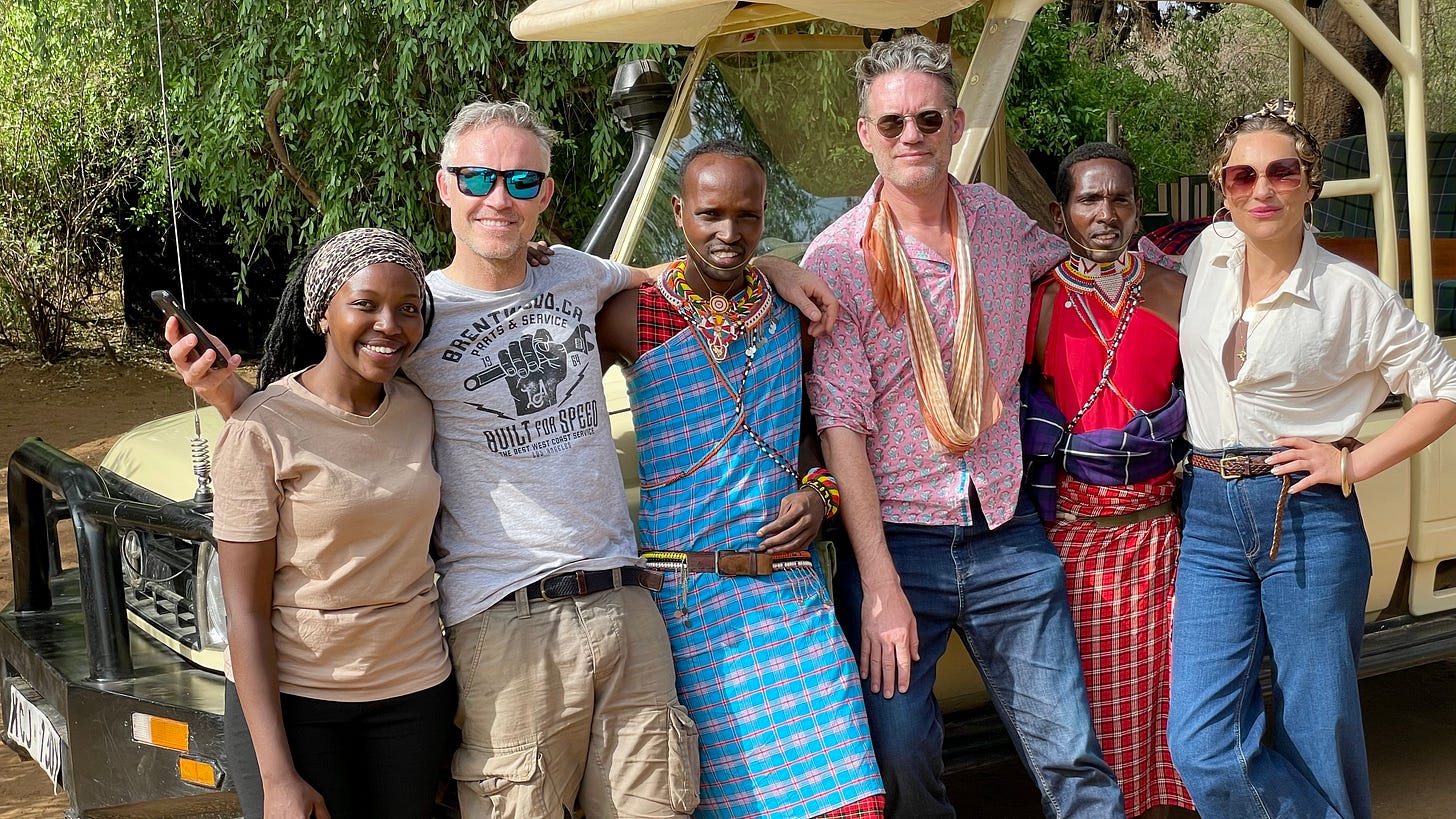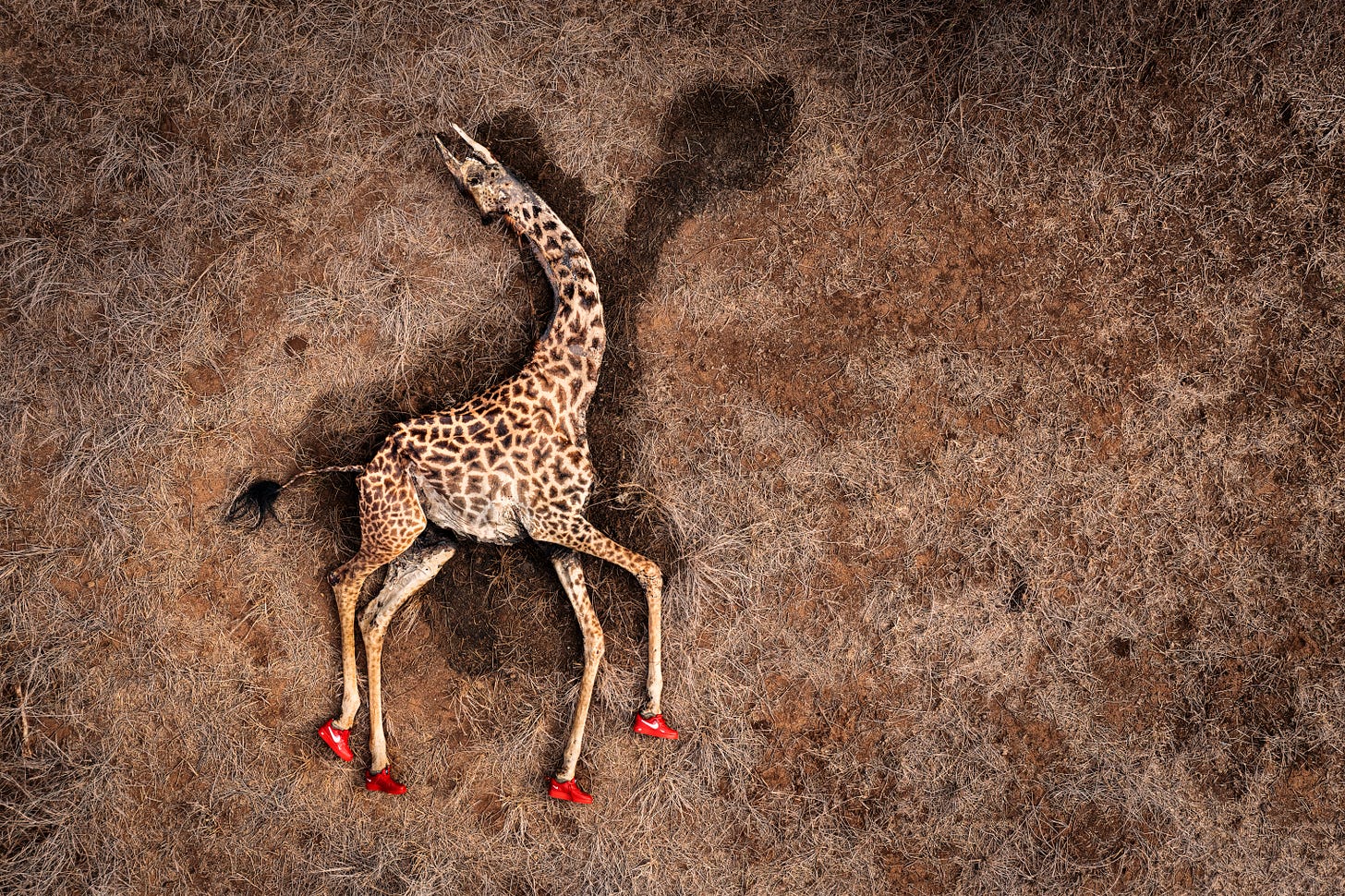Here is the introduction to my memoir, The Accidental Coca Lord. I will be publishing it here on Substack over the next few months. It was originally written for Collins and completed last year, but I pulled out of my deal before publication because they really pissed me off. I’ll be putting the first few chapters out for free subscribers and then publishing the rest for paid subscription. Anyway, I hope you enjoy.
For more information on The Accidental Coca Lord and to get caught up click here
INTRODUCTION
‘Nothing’s perfect. Perfection is a myth and there’s always room for improvement. You just have to completely destroy yourself, everything you love and everyone in your life, in pursuit of it.’
I was in northern Kenya last week, photographing Lady Martha Sitwell, in all her seventies-styled flamboyance. She was dressed in an extraordinary electric blue Julia Clancy kaftan and turban; her wrists dripping with gold bangles. Spread relaxed on an ivory felt blanket, she struck the poses only a professional model can so effortlessly pull off, while pretending to stare at her phone. A bottle of Chardonnay lay toppled on the white sand next to her, a glass sat empty to its side and the enormous, drought-exhausted corpse of a recently dead elephant rotted a few feet behind her, its guts torn out the previous night by hyenas.
My field producer, Pauline Kyalo, irritated me as she ran in to make a minor adjustment to the pillow that Martha rested her head on. I was concentrating so hard on the composition that I’d forgotten the detail, but Pauline, always on point, always with a smile, had my back. ‘You’re a genius!’ I shouted as she ran back to the Land Cruiser where I was leaning in through the driver’s side window trying to get shade from the burning sun. As I stared at the image, beamed live to my phone screen from the drone above, I was hit by a weird sense of shock and relief at what we’d just created. I hit the button on the drone remote, which snapped one final picture. It was a vision so totally horrific, so utterly fucked up, that none of us had ever seen anything like it; but I couldn’t keep the grin from my face. I was holding kryptonite and I knew it.
To the colourfully dressed Samburu Morans who’d surrounded the car and watched on in patient confusion, we were just another bunch of crazy ‘Mzungus’ (Pauline excluded). We’d been working on the image with them for two days, turning the dry riverbed where the elephant, ‘Malawi’, had died, into a beach; cleaning the white sand with a rake, picking up all the sticks and twigs and lumps of hyena shit that surrounded her corpse. They clearly had some idea of what was going on from the image we’d shot the evening before, of Martha in a white silk nighty and full slap make-up, pouting for a selfie in front of Malawi’s corpse, which I’d lit to look like a Vogue cover. The image didn’t really need explanation. It was so obviously mocking the blinding effects of phone-grown narcissism. I explained it to the Samburu guys afterwards, because I felt like such an asshole shooting it in front of them, and also because my buddy Aidan had been winding them up as he always does. But they came down easily, they got it.
As I called it a wrap, Pauline ran out to rescue Martha from the heat of the midday sun and assist her back to the car. I couldn’t afford to get that dress dirty, it had to go back to the shop we’d borrowed it from a few days before. Her shell-heeled Freya Rose platforms too, the soles of which we’d covered in masking tape to stop them getting damaged. (By the way I have no idea who these designers are, I wear ‘three-for-two’ boxershorts.) Aidan, who was filming everything, swung his camera round onto Martha as she tiptoed across the sand to the car, where she grabbed me and began sobbing. I hugged her tight and turned her out of the wind so I could light a cigarette for her. It had taken all her trust to let me put her in that position. The smell was one thing; being the figure in an image that trod such a fine line between making a powerful point and being extremely offensive was another thing all together. But there was never anyone else, it was always Martha. Not just because we loved each other and because she always just looked like an empress. But also because the infectious energy and exuberance she presented to protect herself masked a person exhausted by trauma, finding safety in the rabbit hole of her phone – and that’s what the image was about, turning effortlessly away from grim reality, to the safety of our phones.
When we got back to camp on the banks of the dried out Ewaso Ng’iro River, I downloaded the picture I’d shot and stared at it for a while, letting it sink in. It was one of those rarest of things, it was actually better than the image that I’d had stuck in my head for months. It was always a sunbathing on the beach shot, but I never dreamed we’d actually find a dead elephant on a sandy beach, I assumed they’d all be in scrub. Our first job had been to drive around, following GPS coordinates for eighteen dead elephants, to see if we could find one that looked right. The first one we looked at had just been a sun-bleached skeleton, Malawi was the second.
I knew the image had worked the instant it came up on my laptop screen. And then I did what I always do, got excited by it and loved it briefly before beginning the process of realising where I’d failed – the blanket wasn’t angled perfectly, so the composition was slightly off. The blanket also had a crease or two along its edges, which annoyed me, and the tiny tassels at the end of it hadn’t all been placed perfectly. I knew the process though. The details would consume me for a while, then I’d ignore them and like the image, then the doubt would creep back in. I’d look at it with different eyes, sometimes loving it, sometimes hating it, every time I looked at it, probably for the rest of my life.
Aidan pulled me aside after lunch and sat me down in front of his camera outside my tent, to ask me a few questions. We bumped our way through the obvious. ‘What does the image mean? What are you going to do with it?’ I tried to be philosophical, tried to be funny, tried to sound wanky like an artist. Until he eventually asked, ‘When we first found the elephant, everyone was very sombre, Martha and Pauline were crying, but you seemed absolutely fine. In fact you were just pissing about making jokes about everything. Why do you think that is?’
I diminished myself with a grin and answered upbeat, showing off with my blasé experience. ‘You know there was a point when I’d photographed more dead elephants than live ones’, I replied. ‘I’ve seen so many dead elephants that standing next to one doesn’t bother me anymore.’ It’s a line I’d rolled out a few times before. But this time, as the words came out of my mouth, my voice cracked and my eyes filled with tears. I chuckled as I tried to bust through; but in the end I gave up, slightly embarrassed. I took a moment to compose myself. ‘I know it all goes in’, I said. ‘I don’t consciously think it does, but I know it’s all loading up in there, however much I try and brush it off.’ Then I diverted. ‘I don’t even like elephants that much. They’re just big cows with long noses to me. I’m not one of these people that goes all gooey over them.’ Aidan sat patiently while I collected myself. We’ve been best mates since we met filming the BBC series Big Cat Diary in the late nineties, but I’m still in the process of being able to show my emotions, especially in front of my mates. ‘How did you come up with the concept?’ he eventually asked.
I explained that a few months previously I’d been in Kenya on a National Geographic Society grant, covering the drought, the worst in living memory. I’d spent a couple of weeks in the shadow of Kilimanjaro, driving around the group ranches and conservancies that surround Amboseli National Park. Dr. Paula Kahumbu, a fiercely active African conservationist, and I were joined by a Kenyan film crew, trying to get images and film of the dire situation, powerful enough to bring some attention to the drought, which was being ignored by the world’s media. We’d tried to cover the issue from all angles: climate change, overgrazing, habitat loss, all the usual culprits. We’d seen more death in that week than any of us had ever seen before. Driving across Amboseli National Park was like a scene from the Somme; the carcasses of wildebeest and zebra lay scattered in endless succession across the denuded, empty landscape. We’d met farmers who’d lost everything, one old Maasai guy had lost 390 cows, many of which lay in a distorted pile outside his ‘boma’, their bodies reduced to biltong for dogs and chickens to pick through. The pictures were brutal and powerful. They deserved immediate attention, but they didn’t get it. I sent them to The Guardian, The Telegraph, The Times, The Washington Post, The New York Times; I wanted them in newspapers in East Africa and across the world, but nobody was interested.
One evening, during that shoot, while going through my pictures at camp, I found myself staring at an image of a giraffe that had died of starvation. As its body had dried in the sun, a tendon had popped through the skin of its neck and dragged its head back, leaving a wretched and disturbing dark mark in the sand, where its head had lain. It was powerful, but it was missing something – it was only telling half a story. It was a dead giraffe alone in a desert, so dried out that even the flies were ignoring it. The reason it was dead was absent from the image, it was the result not the problem. I needed to add the problem into the image to tell a whole story. And the palette was flat and dull, brown on brown. It needed something striking and colourful, something obtuse and disturbing, to bring it back to life. I lay in bed that night trying to work out what I could do with it, until it dawned on me. The next morning, I phoned Pauline in Nairobi. ‘Can you get me two pairs of the largest red Nike trainers you can find and bike them down to me?’ The following day I headed out early and forced both pairs of rip-off Nikes onto the giraffe’s giant hooves.
When I show people the bizarre picture on my phone, always with a wry grin, they can’t ever quite comprehend what they are looking at. At first they assume it to be fake, so I show them a video of me fitting the shoes. Then they look at me with disgust and disappointment and think I am a complete prick. And then I tell them the title – ‘The World’s Going to End, but You Can Buy Cool Stuff’ and in an instant their faces change, because they suddenly get it, because it makes sense, because it’s true. That instant turnaround – from confusion to understanding – is fascinating to me. If I can do that with one image and a title, I can do it with more.
‘Scrolling to Indifference’, the title of the image of Martha and the elephant, came to me one morning while I was sitting on the toilet with a terrible hangover, looking at crap on my phone. As I browsed the overnight Instagram offerings, I suddenly realised that I’d just scrolled past the news that the world’s last male northern white rhino had died and the species had, therefore, become functionally extinct. I hadn’t even bothered to properly register it; I’d just scrolled on by. Even when I thumbed back to see the image of Sudan, taken by my Nat Geo colleague, Ami Vitale, I still didn’t bother to read the story, I just glanced at the caption. I had allowed my phone to rob me of my ability to concentrate or care. I realised that every morning I got up and got bombarded with misery and shit and that I was so used to it that I had stopped reacting. The title came before the image, but I knew I had to create something so disturbing that people wouldn’t be able to just scroll past it.
Martha and I schemed her dress code for the image over several months, usually at a little Italian restaurant on Grays Inn Road, where we’d treat each other to lunch, occasionally stepping outside to smoke her Marlboro Reds. Eventually she persuaded me to visit a little shop in Marylebone called Kokoro, to try on a selection of exquisite dresses and kaftans, with the shop owner Dawn, who was a little embarrassed by Martha’s complete disregard for formality, as she threw her clothes off in front of us in her excitement to try everything on, explaining, ‘It’s ok darling, I used to be a model.’ The electric blue kaftan was an instant decision, the moment she slipped it on. It was so striking that there was never any question. I look at the image now and I realise why. Although I want to look at the picture as a whole, my eye is constantly drawn away from the elephant and down to Martha. And that’s the point, she’s just much easier to look at. It’s a baseball-bat-in-the-face image; it creates a visceral jolt of emotion in the viewer. Like the giraffe, it’s witty and funny, and that’s what makes it so dark and powerful. It’s everything I have spent my life obsessively searching for. I just never thought it would all finally make sense one morning while sitting on the crapper scrolling through Instagram.
This book is, I suppose, the background to how I ended up lying Martha down next to an elephant corpse and why I stuck a couple of pairs of knock-off red Nikes on a dead giraffe. It is a collage of a life drawn from memory, diary, the films I made for the BBC and the stories I shot for National Geographic magazine. I hope it paints an honest picture of what I experienced on my journey to get what I considered to be the perfect photo, and how what I saw, perhaps, represents the deep and concerning complexities of a planet’s ecosystems in collapse. I have tried to make the content more about what I saw than about who I am; although, like this introduction, I am guilty of self-indulgence sometimes. It is neither a book about photography nor conservation, but hopefully the marrying of these two subjects. And don’t worry, it’s not all sad, there are a few dick jokes, there’s the odd romance and on more than one occasion, some fantastic drugs. There’s even a bit about that time I bought an illegal coca plantation in Peru by mistake…
For my boys Fred, Gus and Arthur. Don’t make the same mistakes that I made. Make your own.
Dad x









Wow. This is incredible. Whoever sees this, read it.
Wow. Your writing is as gripping as your images.